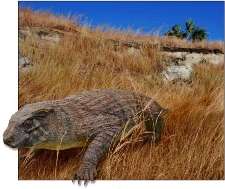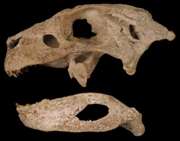Bizarre fossil crocodile dispels notion that these reptiles are static and unchanging

(PhysOrg.com) -- We all know that crocodiles are reptiles with long snouts, conical teeth, strong jaws and long tails. But according to researchers at Stony Brook University in New York, we don't know what we thought we knew. Rather, some crocodiles possessed a dazzling array of adaptations that resulted in unique and sometimes bizarre anatomy, including blunt, pug-nosed snouts, pudgy bodies and short tails.
These anatomical adaptations of the incredibly diverse group of reptiles called notosuchian crocodyliforms are brilliantly illuminated in a new Memoir of the Society of Vertebrate Paleontology. This massive, richly illustrated volume, edited by Drs. David W. Krause and Nathan J. Kley of Stony Brook, clearly dispels the notion that crocodiles are static, unchanging "living fossils."
The volume, which gives an account of fossil crocodyliform anatomy that is unprecedented in its thoroughness, is set for publication on December 8, 2010.
The epitome of crocodyliform anomaly is represented by Simosuchus clarki, which lived in Madagascar at the end of the “Age of Dinosaurs” (about 66 million years ago). First described preliminarily in 2000 from a well-preserved skull and partial skeleton, Simosuchus shattered the crocodyliform mold with its blunt snout, leaf-shaped teeth, and short, tank-like body covered in a suit of bony armor.
“Simosuchus is easily the most bizarre crocodyliform ever found,” declared Dr. Christopher Brochu, a leading expert on fossil crocodiles from the University of Iowa.
Over the next decade, expeditions to Madagascar recovered more skulls and skeletons, now representing nearly every bone of Simosuchus. A reconstruction of this uncommonly complete fossil reptile and an interpretation of its place in the crocodile evolutionary tree became the subject of the new volume.

“The completeness and preservation of the specimens demanded detailed treatment,” said Krause, Distinguished Service Professor in the Department of Anatomical Sciences at Stony Brook University. “It just seemed unconscionable to not document such fantastic fossil material of this unique animal.”
Brochu, who did not participate in the research, said that “very few crocodilians – even those alive today – have been subjected to this level of analysis. This reference sets a new standard for analyses of extinct crocodyliforms and is going to used for decades.”
A separate chapter of the monograph is devoted to each of the major parts of the animal – skull, backbone, limbs, and armor.
“The skull and lower jaw in particular are preserved almost completely,” said Kley, assistant professor in the Department of Anatomical Sciences at Stony Brook University. “This, combined with high-resolution CT scans of the most exquisitely preserved specimen, has allowed us to describe the structure of the head skeleton – both externally and internally – in exceptional detail, including even the pathways of the tiniest nerves and blood vessels.”
But while it is easy to lose one-self in the details of these incredible fossils, one of the most amazing features is the overall shape of the animal. Two feet long, pudgy, with a blunt snout and the shortest tail of any known crocodyliform, Simosuchus was not equipped to snatch unsuspecting animal prey from the water’s edge as many modern crocodiles do.

“Simosuchus lived on land, and its crouched posture and wide body probably meant it was not very agile or fast,” said Joseph Sertich, a Ph.D. student in the Department of Anatomical Sciences at Stony Brook who participated in the research.
In addition, its short, under-slung jaw and weak, leaf-shaped teeth show that it probably munched on a diet of plants. While the idea of a gentle, vegetarian crocodile is unusual to us today, the new memoir makes it easy to imagine Simosuchus ambling through its semi-arid grassland habitat, pausing to nip at plants and crouching low to hide from predators like the meat-eating dinosaur Majungasaurus.
The paleontologists also found evidence that pointed to the evolutionary origin of Simosuchus. “Interestingly, an analysis of evolutionary relationships suggests Simosuchus’ closest relative lived much earlier, in Egypt,” said Sertich.
Details like these are crucial to deciphering the pattern of the dispersal of life around the globe, an area of scientific study known as biogeography. Whatever its ancestry, Simosuchus has set a surprising new standard for what constitutes a crocodile.
More information: The article appears in the Journal of Vertebrate Paleontology 30(6, Supplement) published by Taylor and Francis. - www.vertpaleo.org/
Provided by Stony Brook University



















